No trip to Morocco is complete without sleeping in a stunning riad, snapping photos of colorful doorways, treasure hunting in the souks, or sampling the delectable Moroccan food! Rich, exotic flavors of olives, lemon, and saffron melt in your mouth and will have you licking your plate.
Strange flavor combinations like savory chicken pastries topped with sweet powdered sugar don’t make sense on paper but make perfect sense on your tongue. You owe it to yourself to sample all of the local flavors at least once. Follow our guide to ensure you hit all of the highlights!
Also, make time to take a Moroccan cooking class during your trip so you can continue enjoying the flavors of Morocco after your return home.
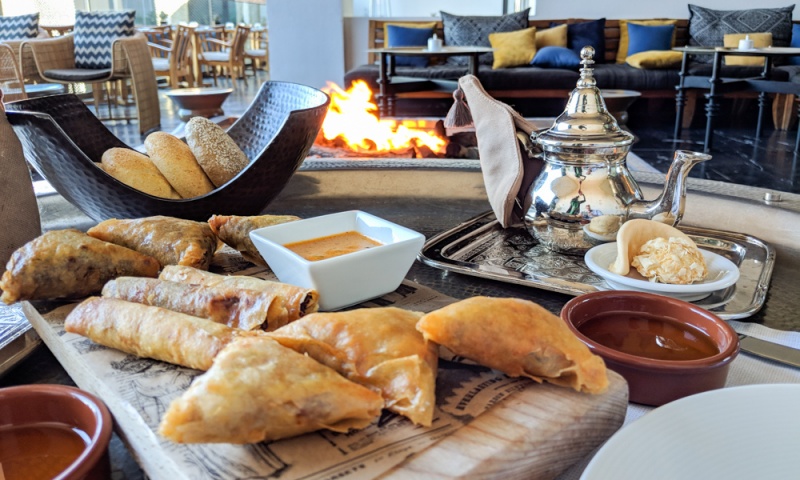
Don’t forget to check out our web story: Moroccan Food: 22 Dishes You Must Try in Morocco!
Disclaimer: This post may contain affiliate links. If you make a purchase or booking through one of our links we may earn a small commission (don’t worry, it’s at no extra cost to you).
22 Must-Try Moroccan Foods!
1. Olives
Morocco is the 5th largest producer and exporter of olive oil in the world. You’ll probably get a little bowl of spiced olives before every meal. And they make their way into pretty much every Moroccan food dish. If you’re not an olive lover, get used to picking them out of your Moroccan food!
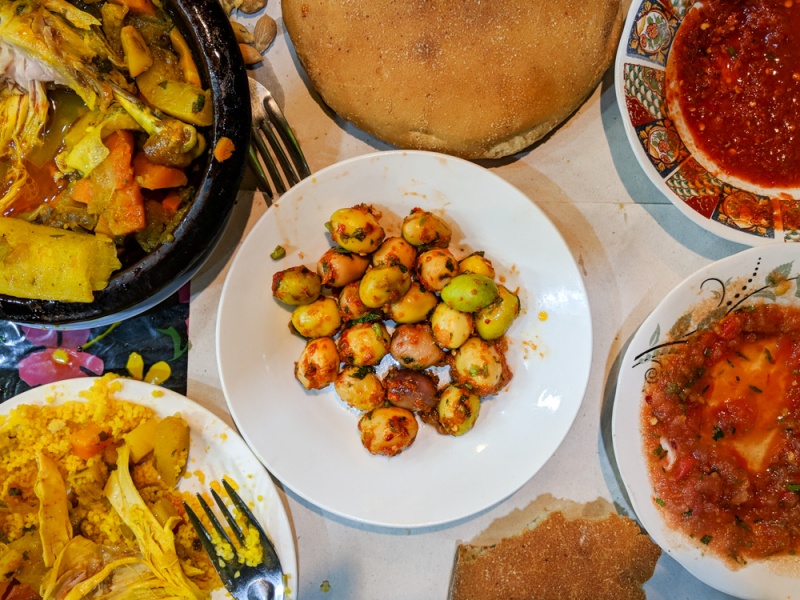
2. Bread
Moroccan khobz (bread) is also generally doled out prior to every meal. Many Moroccan families bring their dough to bake in the communal wood-fired ovens found in every town across the country.
A typical Moroccan breakfast generally consists of french bread, butter, honey, and an assortment of jams. Each person will also typically receive either a piece of msemen (flaky, layered flatbread) or of baghrir (a spongy pancake).
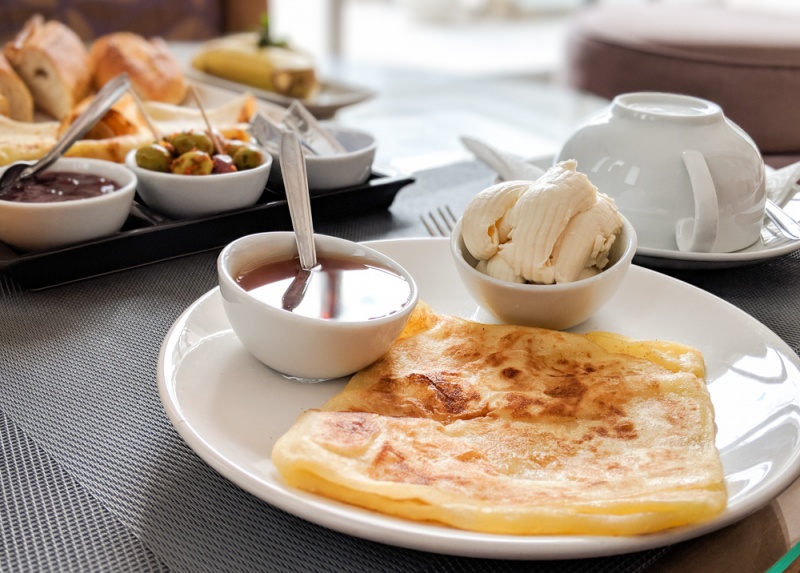
3. Harira (Moroccan Soup)
This thick, creamy soup is full of chickpeas and usually contains whole chickpeas, noodles, and occasionally pasta. Traditionally it serves as a starter or during Ramadan to break the fast at dusk.
It is served in most restaurants and by many street vendors.
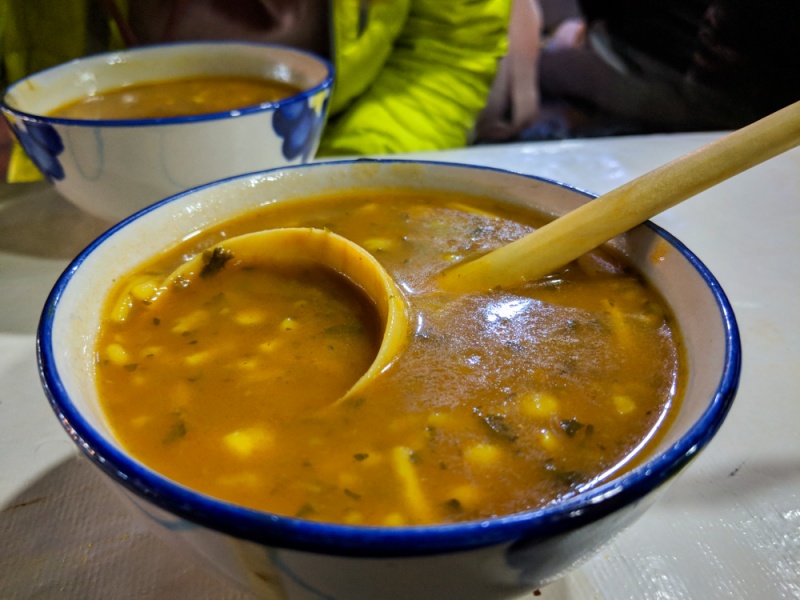
4. White Harira Soup
This breakfast concoction recipe includes semolina, milk, water, olive oil, and spices. It looks a bit like traditional porridge but doesn’t have the same sweetness. In fact, it’s a bit bland unless you top it with more oil and spice.
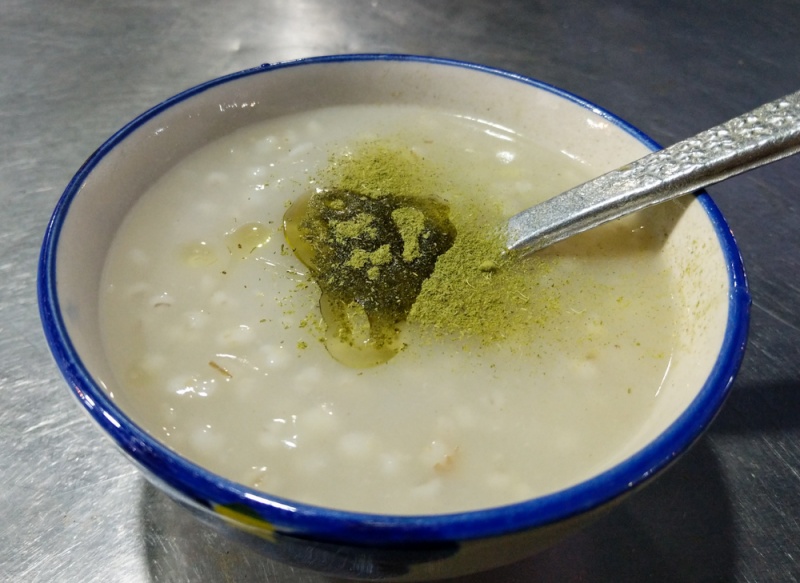
5. Moroccan Salads
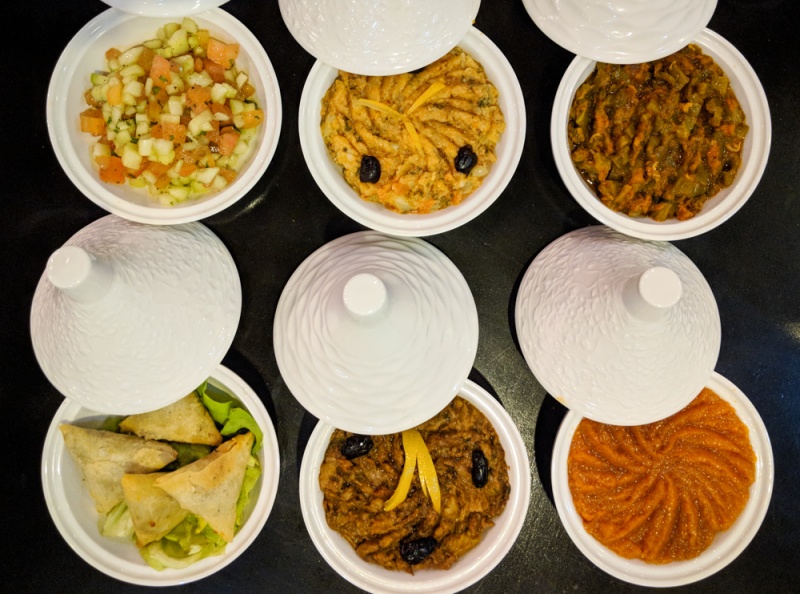
It is typical among Middle Eastern countries to serve a variety of cold “salads” (which are actually more like dips) as an appetizer before a meal. A few of the most common include:
- Tomato Jam: This dip is the consistency of jam but made with roasted tomatoes and then sweetened with honey, cinnamon, and orange flower water.
- Zaalouk: This Moroccan salad has cooked eggplant, tomatoes, and spices. You can eat it alone or use bread to scoop and eat.
- Matbucha: This cooked dish of tomatoes and roasted bell peppers is a bit spicy from the garlic and chili pepper.
- Taktouka: This smoky flavored cold salad has green bell peppers, tomatoes, garlic, and olive oil. The vegetables are chopped rather than pureed like many of the other salads.
6. Briouats
Similar to samosas, briouats are a sweet or savory stuffing wrapped in warqa (filo dough) and fried. The stuffing is generally some sort of meat like chicken or beef, or simply cheese or vegetables. They can also be served with a sweet filling and served as dessert (described below). They are generally triangular in shape and served as an appetizer to a meal.
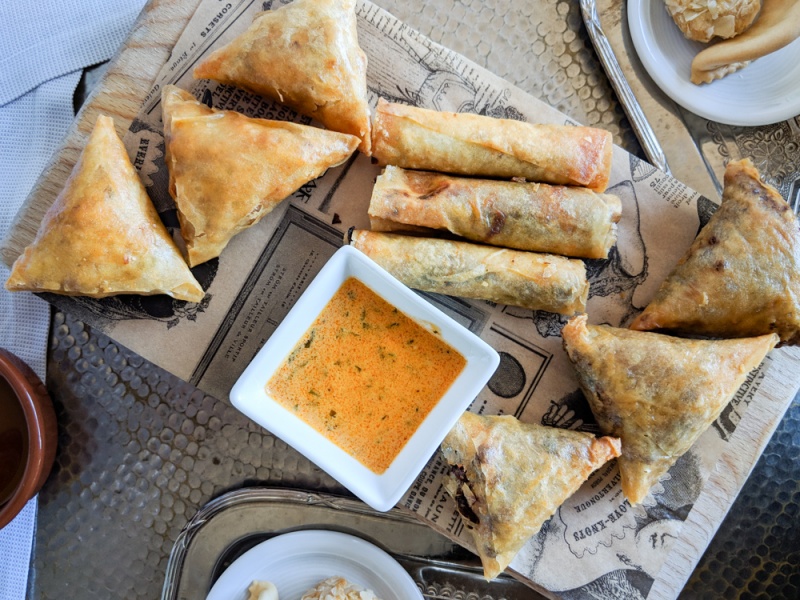
7-10. Tajines
This is probably the most common food in Morocco and one that you’ll find in almost every restaurant in every town. It is a savory stew that is typically made with meat, poultry, or fish together with vegetables or fruit. Everything is slow-cooked together inside of a clay pot with a conical lid (both the food and the clay pot it is cooked in are referred to as a “Tajine”).
Make sure you try all 4 of these typical Moroccan tajines:
- Lamb or chicken with almonds and either prunes, dates, or plums.
- Chicken with lemon and olives
- Kefta with tomato sauce and eggs
- Vegetables
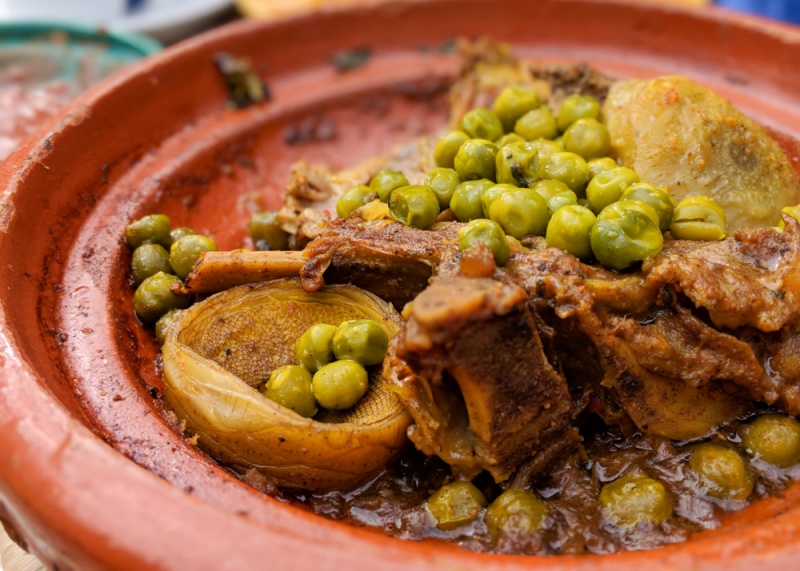

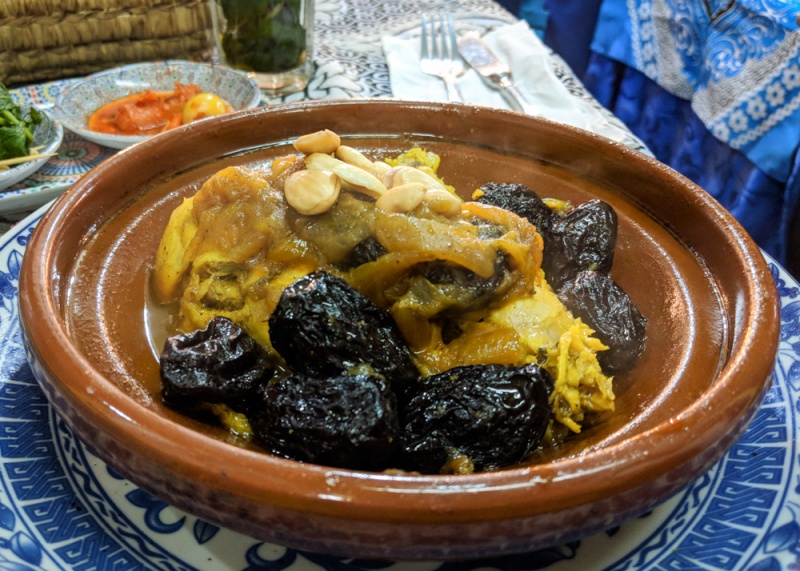
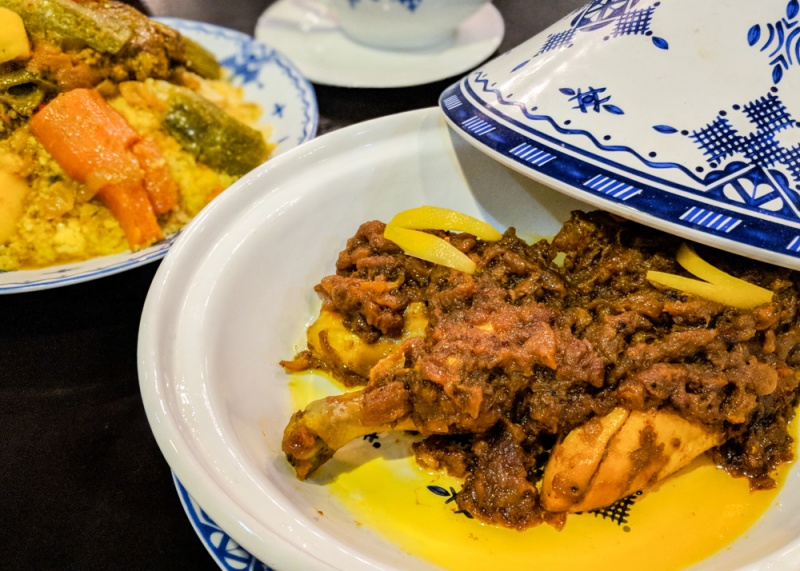
If you can’t fit a traditional tajine in your suitcase, don’t fret, you can easily have one shipped directly to your house!

11. Couscous
This tasty dish consists of very small steamed balls of crushed durum wheat semolina (resembling rice), usually served with a stew spooned on top with some type of meat and vegetables. Traditionally, it is prepared on Fridays (the Muslim holy day) but you can find couscous at most restaurants and cafes on any day of the week.
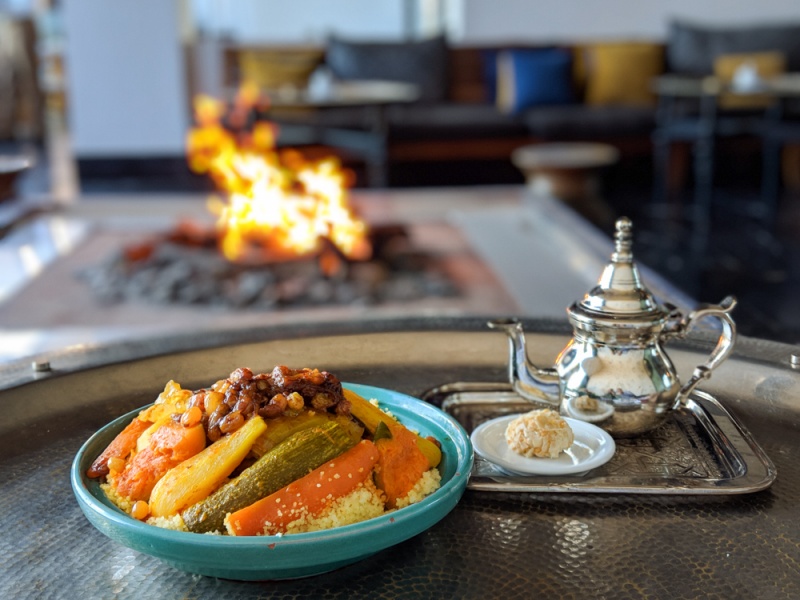
Want to make some Moroccan food at Home? Check out these cookbooks!
12. Snail Soup
You’ll find stalls all over the country (but particularly in Jamaa El Fna in Marrakech) with steaming vats of snail soup and locals gathered around on tiny stools. You’ll pluck the snails from their shells with a toothpick and then sip the incredibly salty broth that many Moroccans believe is good for digestion and fever.
The snails have an earthy, meaty flavor, similar to mushrooms. But their consistency is a bit chewier.
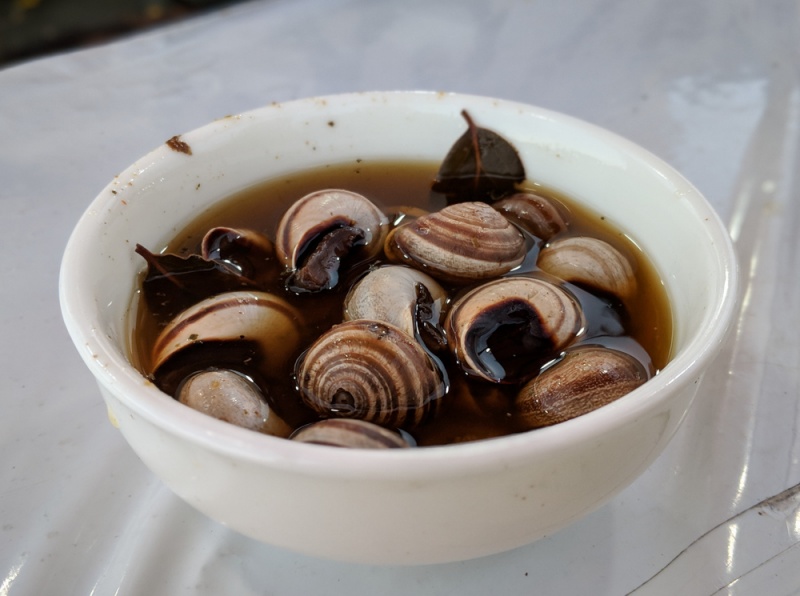
13. Sheep’s Brain
If you head to the Jamaa El Fna as the sun goes down, you’ll find numerous food stalls just starting to fill up with tourists and locals alike. Very aggressive touts will try their best to get you to sit in their tent but hold out until you find one selling sheep’s brain.
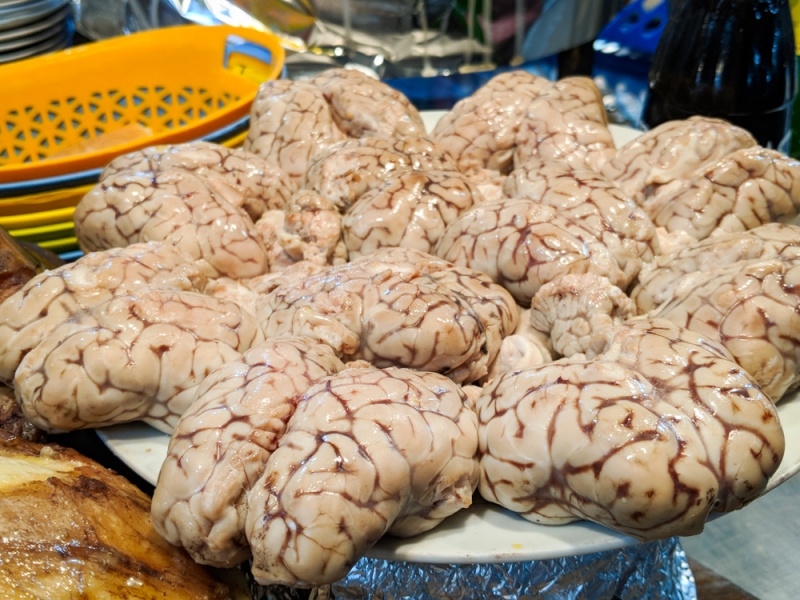
It’s almost unimaginable to eat a whole brain so luckily it comes chopped into small bits. The texture is a bit like day-old gravy or spam. If you get the sauce on top and can handle the gelatinous texture, it’s actually really tasty.
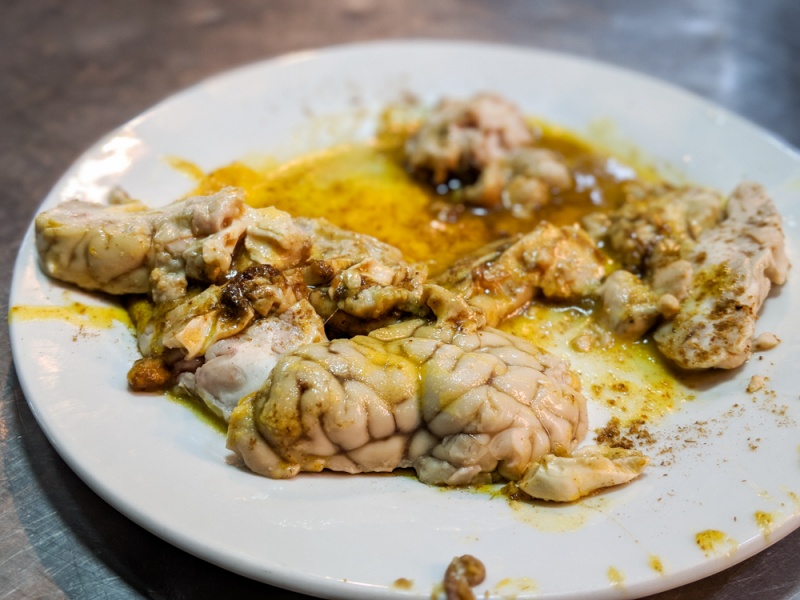
14. Goat Head
This is another delicacy served up in the Jamaa El Fna evening food stalls. And as with brains, if you actually got a head on a plate it would probably be difficult to stomach. But you can order in quarters and it comes chopped into pieces. It’s on the fatty side and tastes a bit like pork belly.
15. Pastilla (Chicken or Pigeon Pie)
If you like sweet and salty all in one package, you’ve got to try pastilla! Traditionally stuffed with pigeon, this flaky pie is served piping hot and dusted with powdered sugar. But it’s more likely to be stuffed with shredded chicken than pigeon these days. Check with your server before you try to order it as many restaurants either run out or don’t have it regularly (even if it’s on the menu).
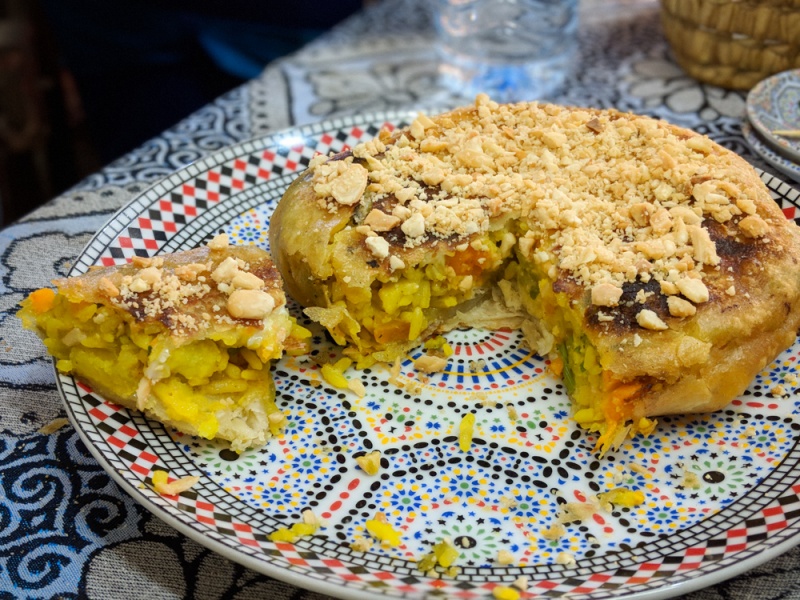
16. Stuffed Msemen
Stuffed msemen is flattened square-shaped dough kneaded together with a mixture of peppers, onion, and tomato and then grilled, rolled, and served to-go! You can find a few street food msemen vendors around the medina in Marrakech.
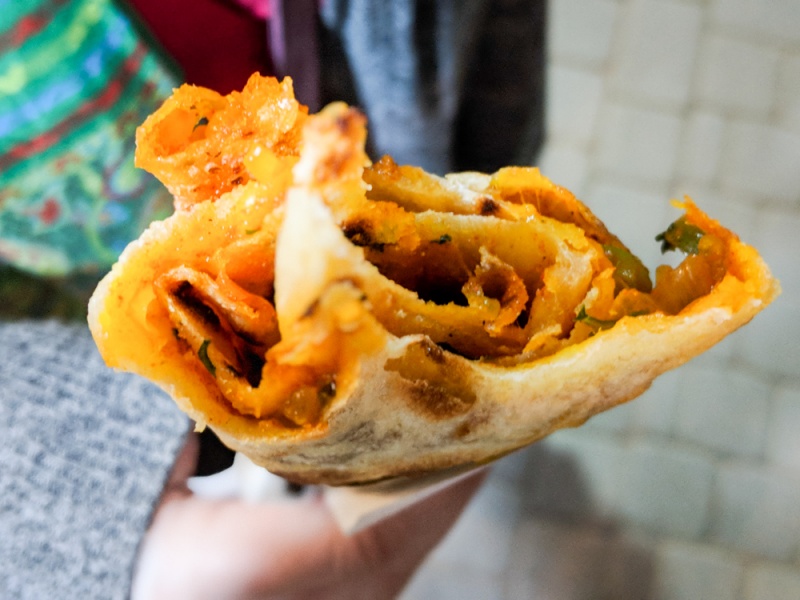
17. “Moroccan Whiskey” (Mint Tea)
This Moroccan favorite is made of green tea, a handful of fresh mint leaves, and a ton of sugar. Expert tea pourers can hit a small glass from a foot or more above. The resulting bubbles are meant to make it more appealing and to show that the tea is ready to drink.
It is generally consumed before meals, after meals, with every meal, and anytime throughout the day (and night).

18. Dates
With over 100 different varieties of dates, it would be a shame not to taste at least a few of them while visiting Morocco. Dates are also eaten to ceremoniously break the fast during Ramadan as the date palm is regarded as the “tree of life” in Islam. You can purchase dates by the pound from stalls in the square or enjoy them cooked in many tajine combinations.
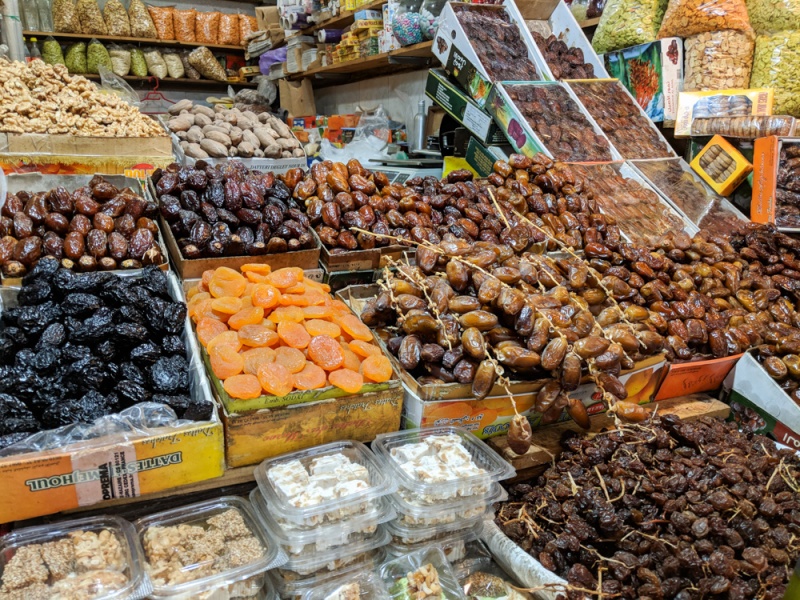
19. Gazelle Horns
These crescent-shaped pastries are made from an almond paste that is scented with orange flower water and cinnamon. They are generally served with an assortment of other sweet treats with your tea.
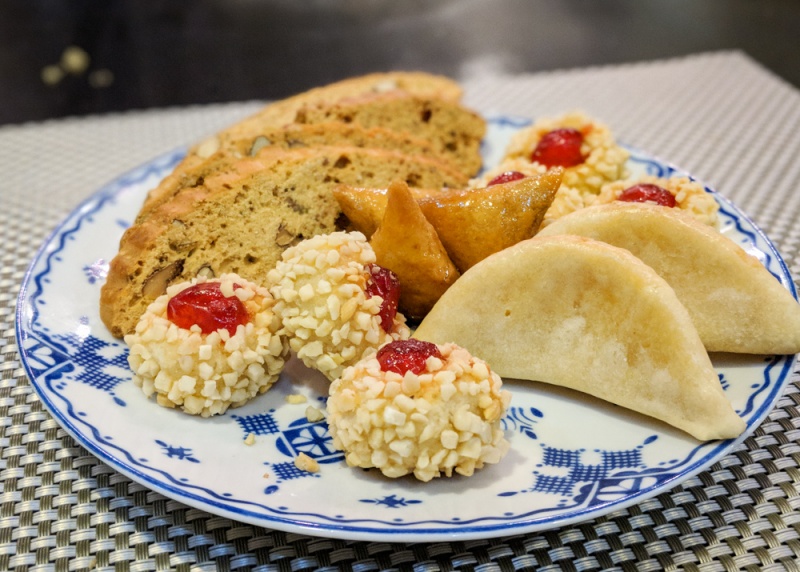
20. Almond Briouats
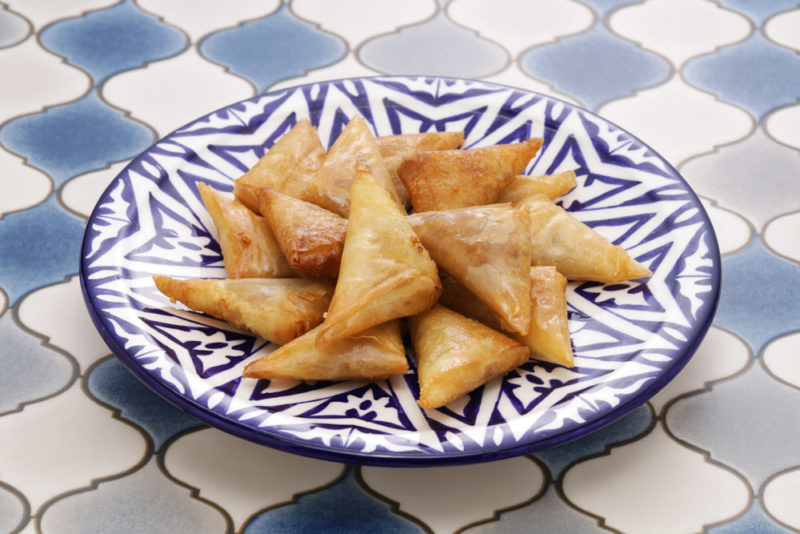
These delicious treats are made of folded dough stuffed with almond paste flavored with orange flower water and cinnamon. They are then fried and soaked in honey. They are sticky, sweet, and highly addicting!
21. Ghoriba Cookies
These chewy, macaroon-like cookies have a crispy, cracked crust. They are often flavored with coconut or almond and always made with orange flower water.
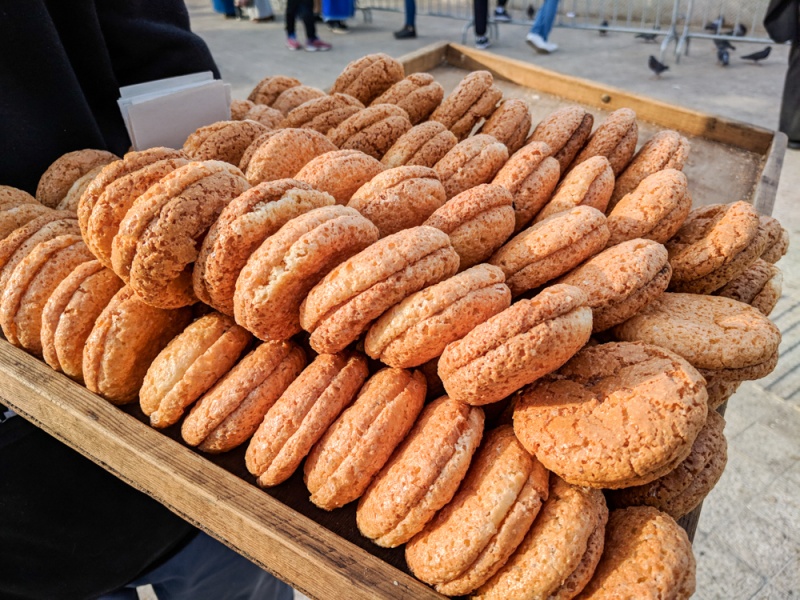
22. Cinnamon Oranges
This simple dessert is just as it sounds – sliced oranges sprinkled with cinnamon. It is often part of the dessert in set menus that many restaurants throughout Morocco offers.
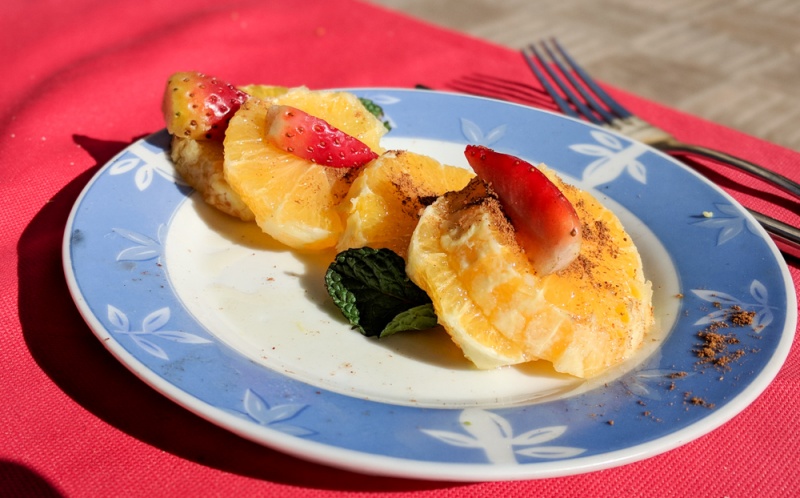
Bon Appétit!
SHARE THIS ON PINTEREST
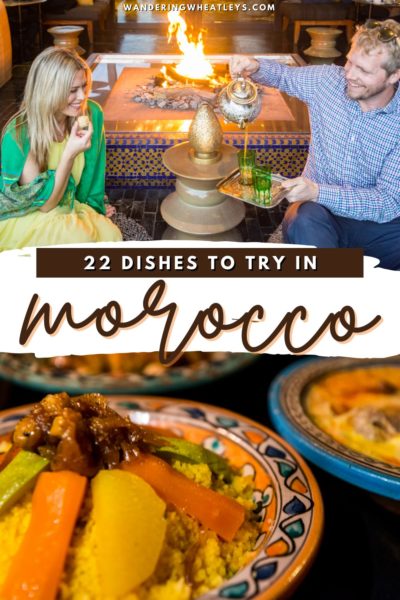
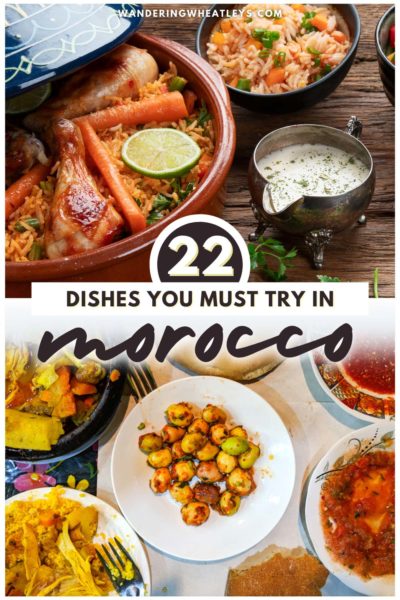
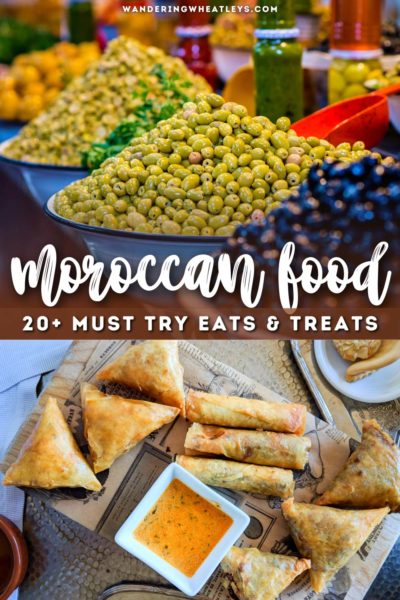

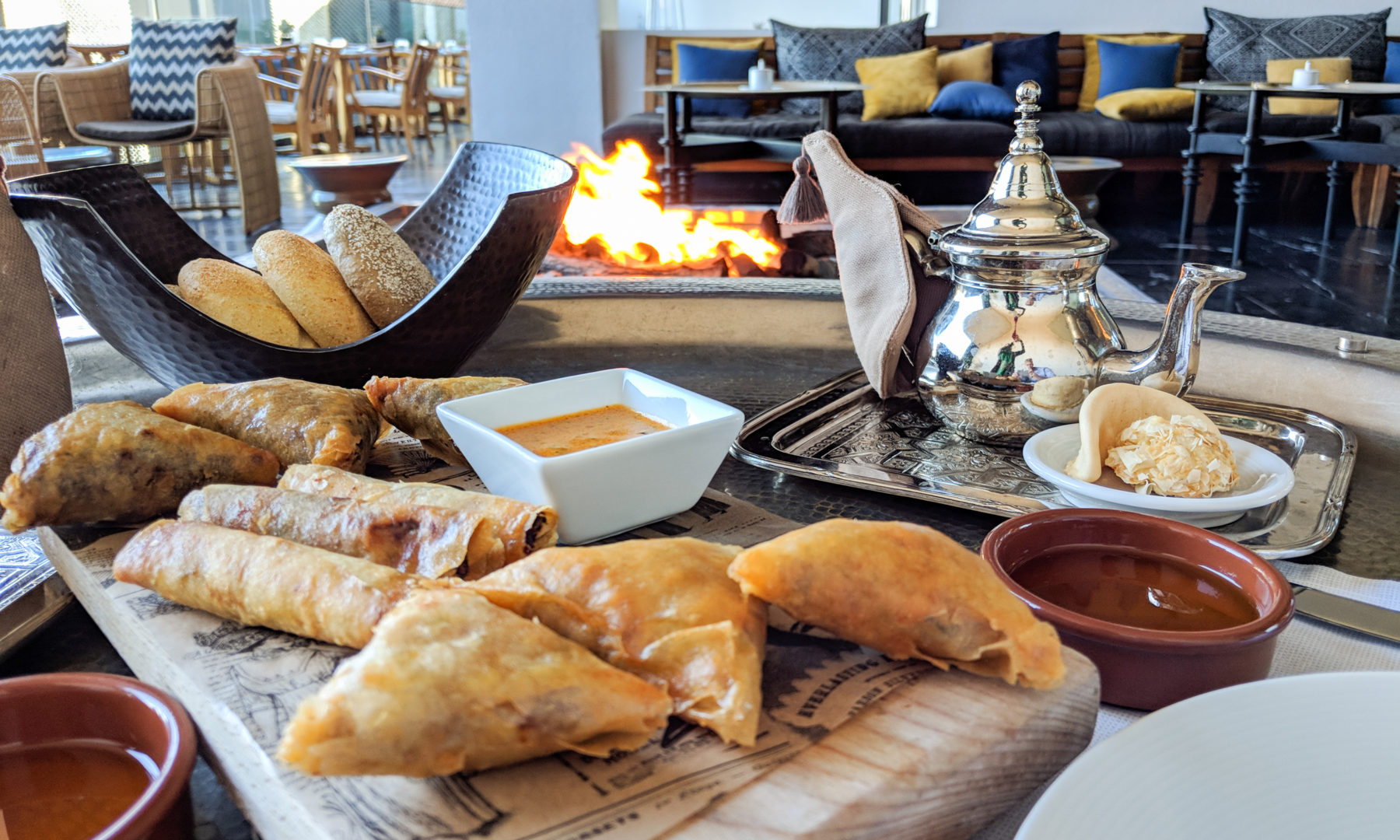





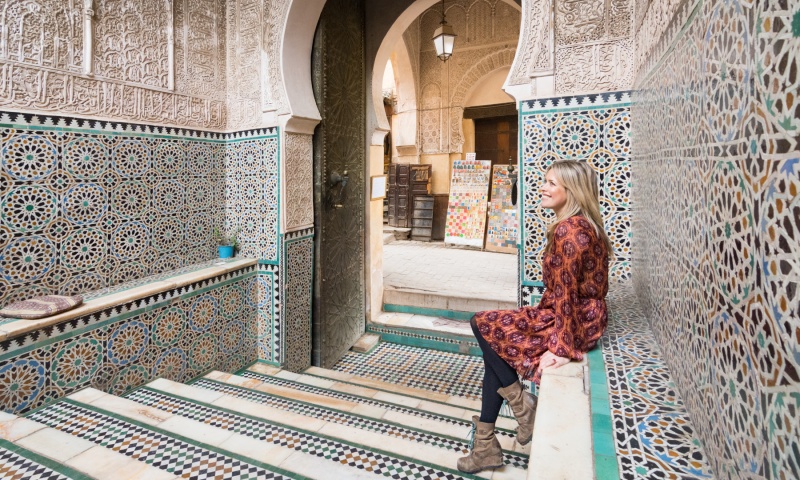
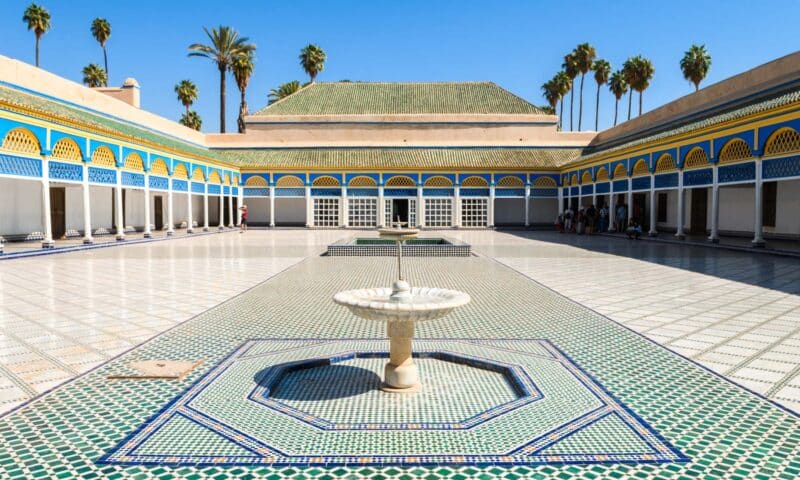
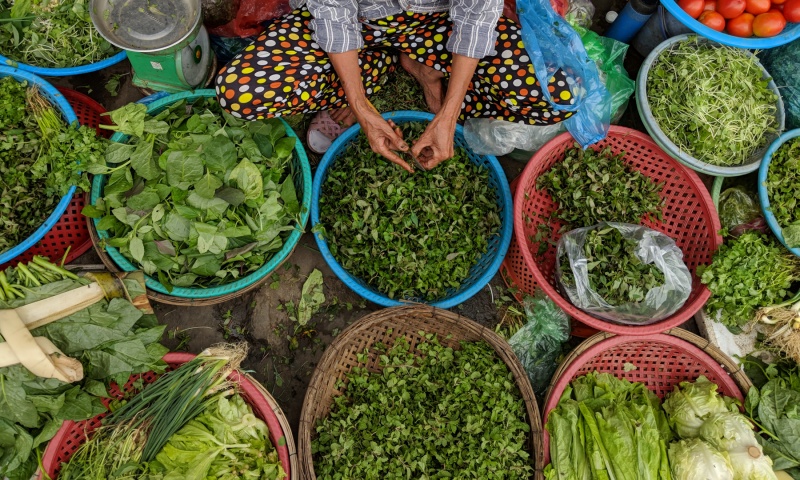
Great article! Just a quick note, though, for the sake of accuracy – Moroccan here :d – the ´Gazelle Horns´ is not the accurate translation for that particular sweet. The name Kaab Ghzal translates to ´ Heel of the Gazelle´ the shape ( see the right side of picture 19).
Another side note, Heel of the Gazelle tastes pretty much like all other Moroccan Almond based sweets, and they come in all sorts of shapes…. I always wondered why we took the time to name that one when we refer to the rest only as ´Almond sweets´.
It tastes great for anybody interested, but if you hate Marzipan, you will hate Kaab Ghzal too.
Tourists should stick to restaurants recommended in the innumerable guidebooks available. Eating at stands on the street or in the markets are a sure road to Montezuma’s Revenge. No one wants to spend their vacation in the loo. I’m talking from experience as one who spends a month in Morocco every summer for more than 20 years.
Great article but there was an error. The part where you compared the samosas to the Moroccan “pastilla”. They are nothing alike! The wraps are totally different, the stuffing is totally different, and the spices are totally different! Also, it is not pronounced “Pastilla” but BASTILLA. Just wanted to bring that to your attention being that I’ve been to Morocco many times and I’m married to a Moroccan for many, many years. He appreciated your article but laughed so hard at the samosas comparison and the “Pastilla” instead of “BASTILLA” pronunciation.
Keep up with your articles, they are appreciated.